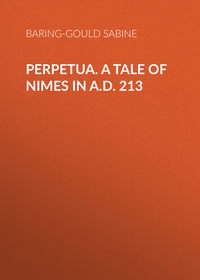 полная версия
полная версияThe Lives of the Saints, Volume 1 (of 16)
[S. Edward is commemorated on this day in the Roman Martyrology, by order of Innocent IV. On this day, he is mentioned in the old English Martyrologies as well, but the festival of his Translation, Oct. 13th, is that which is chiefly observed in his honour, and to that day we shall refer our readers for his life.]
S. GERLACH, H(about 1170.)[Mentioned in the Cologne, German, and Gallo-Belgic Martyrologies. Two lives of this Saint exist, one written during the life of those who remembered him, and were able to describe his personal appearance; the other written by Wilhelm Cripius, son of the Chancellor of Gueldres, by command of the bishop, Henry Cuyck, of Rœrmund.]
Saint Gerlach sprang from a noble family, in the neighbourhood of Maestricht. He was a knight, and lived a somewhat disorderly life; but one day, as he was about to engage in a tournament, the news reached him of the sudden death of his wife, whom he loved passionately. Casting aside lance and shield, he hastened to his castle, and in grief over her loss, formed the resolution of renouncing the world. He visited Rome, and confessed the sins of his life to Pope Eugenius III., who bade him, as a penance, go to Jerusalem, and for seven years nurse the sick in its hospitals. He obeyed, and on his return to Rome, at the expiration of seven years, found Adrian IV. on the throne. Adrian bade him live a retired life. Accordingly, Gerlach returned to his estates, and distributed all his possessions among the poor, reserving for himself only sufficient for his support. He then took up his abode in a hollow oak; but some envious persons having complained to the Bishop of Liege that he offered idolatrous worship to the tree, the bishop ordered it to be cut down; but afterwards, recognizing the virtue of the penitent knight, he became his protector. He wore sack-cloth next his skin, and over that a battered suit of mail. He spent his nights in prayer, in the church of S. Servais, Maestricht.
January 6.
The Epiphany
S. Melchior, one of the Magi. S. Macra, V. M., near Rheims, circ. a.d. 303. S. Melanius, B. of Rennes, a.d. 580. S. Peter, Ab. of Canterbury, a.d. 608. S. Erminold, Ab. of Prufening, and M., a.d. 1121. The Ven. Gertrude Van Oosten, V., at Delft, a.d. 1358. S. John Ribeira, Patr. of Antioch, and Abp. of Valencia, in Spain, a.d. 1611.
THE EPIPHANYThe principal design of the Church in celebrating this feast is, that her members may show gratitude to God for manifesting the Gospel to the Gentile world, and vouchsafing to it the same privileges as to the Jews, who had hitherto been His chosen and peculiar people; the first instance of this divine favour was the Manifestation of Christ to the Wise Men of the East. But, in all, there are three great manifestations of our Saviour commemorated on this day; all of which, S. Chrysostom says, happened on the same day, though not in the same year. The first of these was His manifestation by a star, which conducted the Magi to come and worship Him. The second Manifestation was that of the Blessed Trinity, at His Baptism. The third was the Manifestation of the Divinity of Christ, at Cana, by miraculously changing water into wine.
But the principal event which is this day celebrated, is the Manifestation of our Lord to the Wise Men of the East. These, who are called Magi in Greek, were doubtless men of high rank. Tradition holds them to have been princes or kings; and they are given the names of Gaspar, Melchior, and Balthasar. They are said to have been baptized by the Apostle Thomas, and to have preached the Gospel in Persia. Their bodies were brought by the first Christian emperors from the East to Constantinople, whence they were conveyed to Milan. But the Emperor Frederick I. carried them off to Cologne, in 1162, where they still remain.
Many very curious traditions, of no authority, have attached to these three holy men. They were said to have been Shem, Ham, and Japhet, who had fallen asleep in a cave, and to have woke only at the Nativity of Christ, when they came to adore Him; and then to have returned to their cave and died. A much more trustworthy tradition is to the effect that each wise man belonged to a different stock; that one was of the seed of Shem, another of the family of Japhet, and that the third, represented in art as black, belonged to the descendants of Ham. The three names Gaspar, Melchior, and Balthazar, are not found in any writers earlier than the twelfth century. Before Pope S. Leo the Great spoke of them as three, the number was sometimes supposed to have been as many as twelve. Barhebræus says, "Magi came from the East. Some affirm that three princes came with a thousand men; but James, the bishop (of Edessa,) said that there were twelve princes, who, having left seven thousand soldiers at the Euphrates, came on with a thousand men to Jerusalem."
Some authors have suggested that the seeming star, which appeared to the Magi in the East, might be that glorious Light which shone upon the shepherds of Bethlehem, when the angel came to impart to them the tidings of our Saviour's birth, which, at a distance, might appear like a star. According to an ancient commentary on S. Matthew, this star, on its first appearance to the wise men, had the form of a radiant child, bearing a sceptre or cross; and in some early Italian frescoes it is thus depicted: —
"In a trice a star shone forthOh! so brightly shining!Nearer, nearer yet it came,Still towards earth inclining;And 'twas shaped – O! wondrous sight!Like a child with visage bright,Holding sign of kindly might,With a Cross combining."It is to be expected that the Epiphany, containing in itself, as has been observed, three distinct festivals, would be known by a variety of distinct names. In the Mozarabic ritual it is called the "Apparition of the Lord;" in Germany it is the "Three-Kings' Day."
The Greeks keep the Nativity and the Manifestation to the Wise Men on the same day, the 25th December, and keep the 6th January as the festival of the Baptism of our Lord.
The first historical notice of the Epiphany is found in S. Clement of Alexandria, a. d. 200; in the time of S. Chrysostom, a. d. 400, it is mentioned as an ancient and principal festival of the Asiatic Church. The earliest distinct trace of it in the West is found in Gaul, in the middle of the fourth century. Ammianus Marcellinus (xxi. 2), relates of Julian the Apostate, that in a. d. 361, he celebrated in the Christian Church at Paris, the feast of the Epiphany in January, shortly before he publicly renounced the Christian religion. The title of Day of Lights was given to this festival as commemorating the earthly manifestation of the Light of the World, and also because it was the supposed day of the Baptism of our Lord, to which rite the term "illumination" was especially given. Hence it became, and in the Greek Church it is still, one of the three solemn times of baptism.
Greek Hymn. – O Christ, the True Light, which lighteth every man that cometh into the world, let the Light of Thy Countenance shine upon us, that thereby we may behold the unapproachable Light, and guide Thou our steps to fulfil Thy Commandments.
S. MACRA, V. M(about 303.)[Mentioned in the Roman and German Martyrologies. The account of her martyrdom is from the Martyrologies, and from her Acts, published by the Bollandists.]
During the savage persecutions of Diocletian and Maximian, emperors, one Rictiovarus was governor at Soissons, in Gaul, who laboured to put down Christianity. The virgin Macra was treated by him with inhuman barbarity; she was exposed to fire, her breasts were cut off, and she was rolled on potsherds and coals; then, spreading out her hands, she prayed, "O Lord Jesu Christ, who madest me triumph over the chains in my dungeon, and madest the fire to which I was exposed as sweet as dew, I pray Thee, receive my soul, for now is the time come for Thee to set my spirit free!" So saying, she entered into her rest.
She is regarded as the patroness of Fimes, near Rheims.
In art, she is represented with her breasts on a book which she carries.
S. MELANIUS, B. OF RENNES(a. d. 580.)[Commemorated in the Roman Martyrology on this day. His life was written by a contemporary, according to Ducange.]
S. Melanius was born at Plas, in the neighbourhood of Vannes, in Brittany, and became a monk when grown to man's estate. Upon the death of S. Amandus, Bishop of Rennes, he was compelled by the clergy and people to fill that see. He accepted the election of himself with great reluctance. He is related to have performed many miracles, and to have extirpated the last remnants of heathenism in his diocese. He died on a journey through his diocese, at La Vilaine. His body was placed in a boat, which, says the legend, returned to Rennes against the stream, without oars or sail.
S. PETER, AB. OF CANTERBURY(a. d. 608.)[Named in the English Martyrologies. Authority for his life, Bede. Hist. Eccl., i. 33.]
Bede says of this Saint, that he was a disciple of S. Gregory the Great, and first abbot of the monastery of S. Peter, at Canterbury, which was in later years called S. Augustine's monastery. Going to France in 608, he was drowned near the harbour of Ambleteuse, near Boulogne. The peasants of the place buried the body without much regard, not knowing at first whose it was, but by night a light appeared above it; and, perceiving that the drowned man was a Saint, his body was exhumed, and conveyed to Boulogne.
S. ERMINOLD, AB. OF PRUFENING, AND M(a. d. 1121.)[Mentioned in the German Martyrologies. His life was written by a monk of Prufening, about the year 1290.]
S. Erminold sprang from one of the first families in Swabia, and was given in early life to William, abbot of Hirschau, to be educated. A better tutor could not have been found for him, for William was one of the most learned and pious men of the age. The youthful Erminold made rapid progress in his studies, and he grew up in favour with God and man. When his pupilage was ended, he took the vows of monastic life upon him. In 1110, he was appointed by the Emperor Henry V., to the abbey of Lorch, on the Rhine; but hearing that this had been given him at the request of his brother, as a return for something his brother had done for the Emperor, Erminold threw up the office, so as not to incur the least suspicion of simony, and returned to Hirschau. But the Bishop of Bamberg, having founded an abbey at Prufening, near Ratisbon, he was invited to colonize it, and be its first father. He accordingly betook himself thither, with a few brethren. Having incurred the hostility of some of his monks, by insisting on strict discipline, one, named Aaron, struck him with a knife and mortally wounded him. He died, forgiving his murderer.
January 7
S. Lucian, P. M., at Antioch, circ. a.d. 312. S. Nicetas, B. C., circ. a.d. 402. S. Valentine, B. of Passau, circ. a.d. 440. S. Cedd, B. of London, a.d. 664. S. Tyllo, Monk in Gaul, circ. 700. B. Wittekind, Duke of Westphalia, a.d. 800. S. Rainold, Monk and M., of Dortmund, in Westphalia. S. Aldric, B. of Le Mans, in France, circ. a.d. 855. S. Canute, Duke of Schleswig, a.d. 1133.
S. LUCIAN, P. M., OF ANTIOCH(about 312.)[Commemorated on this day by the Latins, on the 15th October by the Greeks. This S. Lucian is not to be confused with S. Lucian of Beauvais, commemorated on Jan. 8th. He is spoken of by S. Jerome and Theodoret. S. Chrysostom has a homily on S. Lucian. Information concerning him is also obtained from the Greek Menæa, and from the Acts of his martyrdom in Metaphrastes.]
Saint Lucian was born at Samosata, in Syria; his parents were Christians, and sought above all things to educate their son in the fear of God. Both died and left him an orphan at the age of twelve, and the boy, in his desolation, distributed his goods to the poor, and took refuge with Macarius at Edessa, who taught out of Holy Scripture the things concerning eternal life. Arrived at man's estate, he was ordained priest, and opened a school at Antioch, and diligently laboured at procuring a correct version of the Holy Scriptures, by comparing together the different Hebrew copies. His version of the sacred writings was used by S. Jerome, and proved of much assistance to him in his work of writing the Vulgate.
When Maximian persecuted the Church, S. Lucian concealed himself, but was betrayed by a Sabellian priest into the hands of the persecutors; he was taken to Nicomedia, and brought before Maximian. On his way he was the means of recovering forty Christian soldiers, who had lapsed. In Nicomedia he was subjected to torture. His feet were placed in the stocks, which were distended, so as to dislocate his legs. His hands were fastened to a beam, which was above his head, and he was laid on sharp potsherds, so that his back was lacerated and pierced. After this, he was allowed to lie on his cell floor, unable to rise, on account of his legs being out of joint, and was starved to death. He lingered fourteen days. And when the feast of the Manifestation drew nigh, he desired greatly to receive the Holy Eucharist. "When the fatal day had arrived, which was looked forward to, some of the disciples desired to receive from their master his last celebration of the divine mystery. But it seemed doubtful how they might bring a table into the prison, and how they might conceal it from the eyes of the impious. But when many of the disciples were assembled, and others were arriving, he said: 'This breast of mine shall be the table, and I reckon it will not be less esteemed of God than one of inanimate material; and ye shall be a holy temple, standing round about me.' And thus it was accomplished, for because the saintly man was at the end of his life, the guards were negligent, and so God, as I think, to honour his martyr, removed all impediments to that being done which was proposed. For when all stood in close ring round the martyr, so that one standing by the other shut him completely from view, he ordered the symbols of the divine Sacrifice to be placed on his breast. After that he raised his eyes to heaven, and uttered the accustomed prayers. Then, when he had uttered many sacred prayers, and had done all the requisite acts in the sacred rite, he and the rest communicated, and he sent to those who were absent, as he himself shows in his last Epistle to them. Next day some officers came from the Emperor to see if he were still alive. And as he saw them standing about him, he said thrice, 'I am a Christian,' and so saying, he died."
The body was then thrown into the sea, to the great grief of his disciples, who desired to bury it. But fifteen days after it was recovered. A legend says that a dolphin brought it ashore; be that as it may, it was found and was buried.
In art, S. Lucian is sometimes represented with a chalice and Host, in allusion to his offering the holy Sacrifice in prison; sometimes with a dolphin at his side.
S. VALENTINE, B. OF PASSAU(about 440.)[Some German Martyrologies, and the Roman, commemorate S. Maximilian, M., and S. Valentine, B.C., on Oct. 29. But S. Valentine is commemorated alone on this day at Passau.]
Valentine was sent by the Pope to preach the Gospel in the Passau. He found that his work was without fruit, and returned to Rome to implore the Holy Father to send him elsewhere. But the Pope consecrated him bishop, and sent him back to Passau, to preach in season and out of season, whether it produced fruit or not. The Bishop renewed his efforts, but the Pagans and Arians combined to drive him out of the city. Thereupon he went among the Rhætian Alps, and his teaching produced abundant fruit among the mountaineers. At length he resolved to serve God, and purify his own soul, in a life of retirement. He therefore built a little chapel and monastery at Mais, in Tyrol, and there he died.
Relics, at Passau.
S. CEDD, B. OF LONDON(a. d. 664.)[English Martyrologies. His life is given by Bede, in his Ecclesiastical History, lib. 3, caps. 21, 22, 23.]
Peada, son of Penda, King of Mercia, being appointed by his father King of the Midland English, by which name Bede distinguished the inhabitants of Leicestershire, and part of Lincolnshire and Derbyshire, from the rest of the Mercians; the young king visited Oswy, King of Northumbria, at Atwell, or Walton, was baptized along with several of his nobles, by Bishop Finan, and was provided by Oswy with two priests to instruct his people in Christianity. One of these was S. Cedd, who had been trained in the monastery of Lindisfarne. "When these two," says Bede, "travelling to all parts of that country, had gathered a numerous church to the Lord, it happened that Cedd returned home, and came to the church of Lindisfarne to confer with Bishop Finan; who, finding how successful he had been in the work of the Gospel, made him Bishop of the Church of the East Saxons, calling to him two other bishops, to assist at the ordination. Cedd, having received the episcopal dignity, returned to his province, and pursuing the work he had begun, with more ample authority, built churches in several places, ordaining priests and deacons to assist him in the work of faith, and the ministry of baptizing, especially in the city which, in the language of the Saxons, is called Ithancester,31 as also in that named Tilabury (Tilbury); the first of which places is on the bank of the Pante, the other on the bank of the Thames; where, gathering a flock of servants of Christ, he taught them to observe the discipline of regular life, as far as those rude people were then capable.
"Whilst the doctrine of everlasting life was thus, for a considerable time, making progress, to the joy of the King and of all the people, it happened that the King, at the instigation of the enemy of all good men, was murdered by his own kindred. The same man of God, whilst he was bishop among the East Saxons, was wont also to visit, at intervals, his own country, Northumberland, to make exhortations. Ethelwald, the son of King Oswald, who reigned over the Deiri, finding him a holy, wise, and good man, desired him to accept some land to build a monastery, to which the King himself might frequently resort, to offer his prayers and hear the word, and be buried in it when he died; for he believed that he should receive much benefit by the prayers of those who were to serve God in that place. The King had before with him a brother of the same bishop, called Celin, a man no less devoted to God; who, being a priest, was wont to administer to him the word and the Sacraments, by whose means he chiefly came to know and love the bishop.
"That prelate, therefore, complying with the King's desires, chose himself a place to build a monastery among craggy and distant mountains, which looked more like lurking places for robbers, and retreats for wild beasts, than habitations for men. The man of God, desiring first to cleanse the place for the monastery from former crimes, by prayer and fasting, that it might become acceptable to our Lord, and so to lay the foundations, requested the King to give him leave to reside there all the approaching Lent, to pray. All which time, except Sundays, he fasted till the evening, according to custom, and then took no other sustenance than a little bread, one egg, and a little milk mixed with water. This, he said, was the custom of those of whom he had learnt the rule of regular discipline; first, to consecrate to our Lord, by prayer and fasting, the places which they had newly received for building a monastery or a church. When there were ten days of Lent still remaining, there came a messenger to call him to the King; and he, that the religious work might not be intermitted, on account of the King's affairs, entreated his priest, Cynebil, who was also his own brother, to complete that which had been so piously begun. Cynebil readily complied, and when the time of fasting and prayer was over, he there built the monastery, which is now called Lestingan,32 and established therein the religious customs of Lindisfarne."
At this time, owing to the influence of S. Wilfrid, who had been established at Ripon by Alchfrid, son of King Oswy, a great split was forming in the Church, which made itself felt even in the Royal family. All the missionaries of the north had been brought up in Iona, or Lindisfarne, and followed the Keltic ritual; Wilfrid, ordained by a French bishop, introduced Roman ways. Oswy had been baptized and educated by Keltic monks, and followed the usages of the Mother Church of Iona; but his wife, Eanfleda, had learned in exile Roman ways, and she brought with her to the court of Oswy a Canterbury priest – Romanus by name, and Roman in heart – who guided her religious exercises. Two Easter feasts were thus celebrated every year in the same house; and as the Saxon kings had transferred to the chief festivals of the Christian year, and especially to the Queen of Feasts, the meeting of assemblies, and the occasion which those assemblies gave them of displaying all their pomp, it is easy to understand how painful it must have been for Oswy to sit, with his earls and thanes, at the great feast of Easter, at the end of a wearisome Lent, and to see the Queen, with her maids of honour and her servants, persisting in fasting and penance, it being with her still only Palm Sunday.33 To settle this difference, and prevent a rupture, the King convoked a parliament at Whitby, in 664. In this parliament Colman, Bishop of Lindisfarne, Cedd, Bishop of the East Saxons, who had at this time re-established the episcopal see of London, and S. Hilda, the great abbess of Whitby, upheld the Keltic rite. On the other side were S. Wilfrid, the young Prince Alchfrid, and James, the deacon of York. In this parliament, it was decided that the Roman usages should be adopted, and Cedd renounced the customs of Lindisfarne, in which he had been educated, and returned to his diocese of London to spread the Roman usages there.
"Cedd," says Bede, "for many years had charge of his bishopric and of the monastery of Lastingham, over which he had placed superiors. It happened that he came there at the time that a plague was raging, and he fell sick and died. He was first buried in the open air, but in process of time, a church of stone was built in the monastery, in honour of the Mother of God, and his body was interred in the same, on the right hand of the altar."
The Bishop left the monastery to be governed after him by his brother Chad, who was afterwards made bishop. For the four brothers, Cedd, and Cynebil, Celin, and Ceadda (Chad) – which is a rare thing to be met with – were all celebrated priests of our Lord, and two of them also came to be bishops.
S. TYLLO, H(about 700.)[Cologne, German, and Belgian Martyrologies. The name is sometimes Tyllo, Thillo, or Hillo; in Belgium, Theaulon or Tilman. Authority: A life published in the Bollandists, which agrees with scattered notices of him in various writers.]
S. Tillo, the Patron of Iseghem, in Belgium, was a son of Saxon parents, but was stolen, when young, from his home, and sold as a slave in Gaul. S. Eligius, who redeemed many slaves, bought the lad, and being struck with his beauty and intelligence, sent him to the monastery of Solignac, to be educated by S. Remacle, then abbot of Solignac. After his education was complete, he was returned to S. Eligius, who was a goldsmith, patronized by King Dagobert and the nobles of the court. With him Tillo learned the trade of a goldsmith, and made many vessels and ornaments of gold and silver, encrusted with gems, for the King. Whilst he worked, he had the Holy Scriptures open before him, and as he chased the silver and gold he studied the Word of God. He kept ever in his heart the maxim, "Whatsoever ye would that men should do to you, do ye even so to them," and all his work was done to the best of his ability, and executed with punctuality. Thus, he found favour with Eligius, and with all the customers of his master. When Eligius left his shop, and became a bishop, he called to the clerical office and to the religious life, his apprentice whom he had bought in the market many years before. Tillo, as priest and monk, showed a pattern of holiness, and was made abbot of Solignac, near Limoges. But ruling three hundred monks and attending to the worldly affairs of a great monastery, and more than that, the multitude of visitors, made the life one for which the goldsmith's apprentice, trained to work in silence, and think and read, felt himself unfitted; so one night he fled away and was lost. He penetrated the woods and mountains of Auvergne, seeking out a suitable spot for a hermitage, and one day he lit upon a quiet place, hid away among the rocky mountains, into which he could only just crawl on hands and knees. Having got in, he found a pleasant glade, surrounded with trees, having streams watering it from the mountain side, and there were plenty of apple trees, from which he concluded it had been previously a hermitage. Here he lived for some time, praying and reading, and tilling the soil. By degrees, it was rumoured that a holy hermit lived in that glade, and the people of the neighbourhood came to see him, and he called himself Brother Paul. And to all who visited him this was the rule of life he gave, "Believe in God the Father Almighty, and in Jesus Christ his Son, also in the Holy Ghost, three persons, but one God. Keep your mind from vain cogitations and your body pure from all uncleanness; avoid self-conceit, and be instant in prayer."









